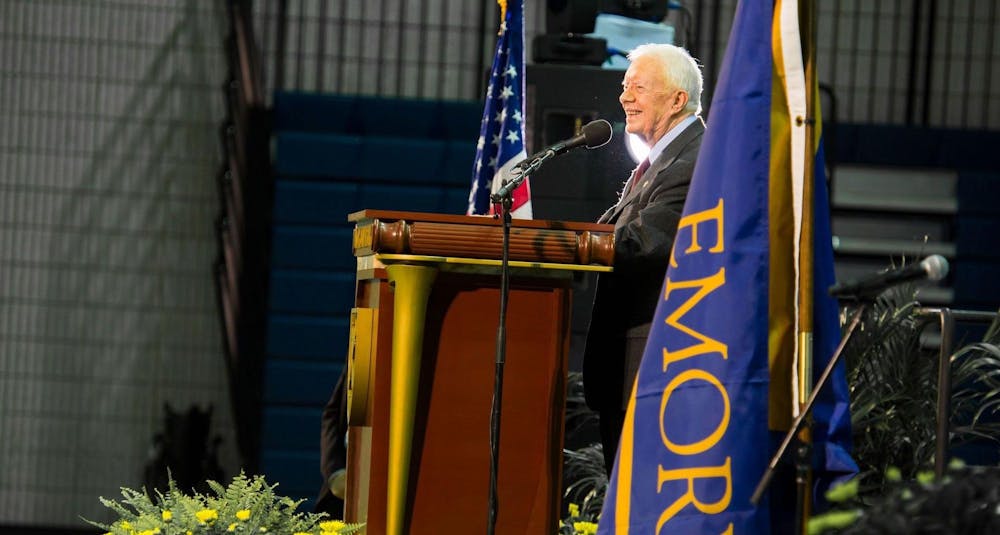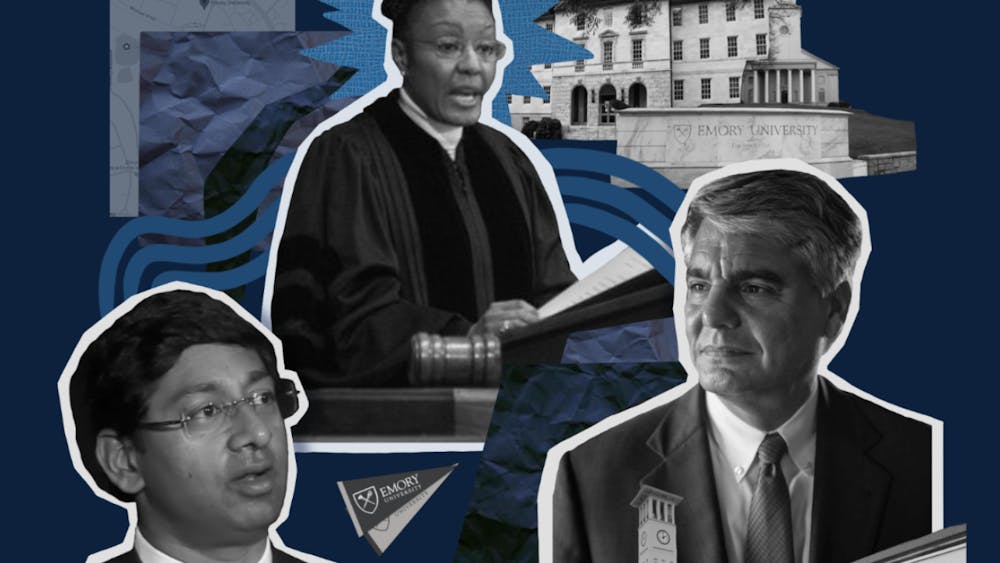Former Editor-in-Chief of The Emory Wheel Jonathan Serrie (87C) arrived on Emory University’s campus just a year after former U.S. President Jimmy Carter joined the University’s faculty in 1982. Serrie described his excitement as a first-year student upon seeing the former president walk into his introductory political science class in Goodrich C. White Hall.
Carter, whose term ended in 1981 — two years before Serrie enrolled at Emory — took his role on campus “seriously,” according to Serrie. The former president was a frequent visitor in classrooms, Serrie explained, noting that Carter did not just stick to political science courses — he also stopped by Serie’s English and journalism classes. Additionally, Carter regularly held town-hall style Q&A sessions with students.
“When I introduced myself as the editor of The Emory Wheel, he said, ‘I read the Wheel regularly, that and The New York Times,’” Serrie said. “He wanted to read the Wheel and just read up on what was going on on campus and what students were thinking.”
Both Serrie and Samuel C. Dobbs Professor of Biology Jaap de Roode see Carter as “down to earth” and “humble.”
“He’s just like a normal person, like your grandfather,” de Roode said. “Every time I’ve met him, he's always just been normal and easy to talk to.”
Serrie and de Roode are two of many Emory community members who have fostered relationships with Carter during the former president's over-40-year relationship with the University. Former University President James Laney convinced Carter to partner with Emory in 1982 due to a shared “ethical” and “moral” vision. Carter agreed, earning the title of university distinguished professor and forming the Carter Center.
Jimmy Carter Professor of History Joseph Crespino sees Carter’s affiliation with the University as consequential to Emory’s “incredible rise.”
“I don’t think that’s just incidental,” Crespino said. “President Carter’s association with the University has been a tremendous benefit to the University and helped raise Emory’s profile around the world.”
Previously, Crespino taught a class on Carter’s presidency. At the end of each semester, the former president visited the class to answer students’ questions.
“It was just always one of the highlights of their Emory careers,” Crespino said. “It was really moving, because they had a connection with them because they'd done this sustained semester-long research.”
Echoing Crespino, Serrie said that having Carter as a professor was a “huge feather” in Emory’s cap.
“Professors were very honored to have him in the class,” Serrie said. “I remember our political science professor coaching us on appropriate etiquette for when a … former president visits and she said, ‘You don’t have to like him politically, but when a president or former president enters the room, you stand up. You don’t have to clap, but you stand out of respect, and then you take your seats.’ There was definitely a sense of pride, a sense of excitement and a sense of deep respect.”
In addition to learning about the Carter presidency, Crespino said he would take his classes to Plains, Ga., and attend Sunday school, where the former president would always recognize and thank Crespino’s class for coming. He called the visits to Plains one of the highlights of his teaching career.
De Roode’s collaboration with Carter took a much different path than Crespino’s. Before he retired from public life, Carter had monthly meetings with members of Emory’s faculty, and it was there that de Roode and Carter began talking about de Roode’s research on Monarch butterflies.
“It turns out his wife, Ms. Rosalynn Carter, she was very much into butterflies, and so I sent a thank you note after the lunch and said if you’re ever interested in visiting the monarchs, let me know, maybe we can assist with a trip there,” de Roode said.
This short meeting developed into what would become The Rosalynn Carter Butterfly Trail. The trail now has partnered with more than 4,000 gardens to recreate habitats for butterflies, according to de Roode.
In addition to his humbleness, de Roode emphasized Carter’s strong will. Through Carter’s work after his presidency, the Carter Center has been able to help eradicate Guinea Worm, train healthcare workers throughout Africa and support democracies across the globe.
However, the Emory community’s appreciation for Carter is not one sided. Carter is proud of his role at the University, with Carter Center Chief Executive Officer Paige Alexander recalling that he used to list “professor at Emory” alongside “former president of the United States” when filling out his occupation on forms.
The former president spoke on this himself at the 2018 Carter Town Hall, saying that he would like to be remembered not only for his acts as president but also for his role at Emory.
“I would like to be remembered as a champion of human rights, as a president who kept our country at peace and as having been a distinguished professor at Emory University,” Carter said.
Serrie said that now, over 40 years after his presidency, people from all sides of the political spectrum respect Carter. He referenced former Rep. Stacey Abrams, who wished Carter a happy 100th birthday on X and highlighted “his unwavering commitment to humanity and peace,” as well as Gov. Brain Kemp, who declared today “Jimmy Carter Day” in Georgia “to recognize his legacy as our 76th Governor and 39th President.”
“While historians will judge the successes and failures of Jimmy Carter’s brief four-year presidency, he’s been a private citizen and a humanitarian for so much longer,” Serrie said. “Through these years and through the decades, he has won the respect of people on both sides of the political spectrum.”

Spencer Friedland (26C) is from Long Island, N.Y. While not working at the Wheel, he is a member of Emory Disability Rights, Education Activism and Mentoring and the Franklin Fellows program. In his free time, he can be found watching the New York Yankees or going to the movies.






